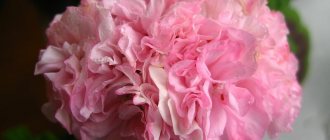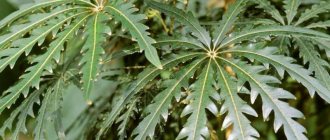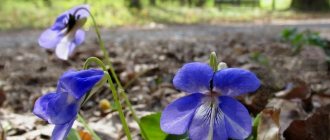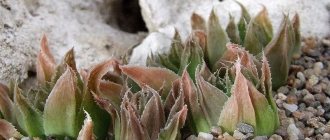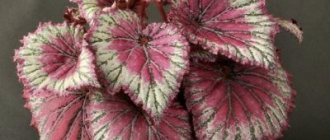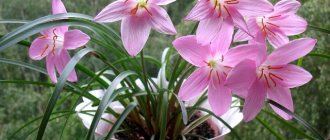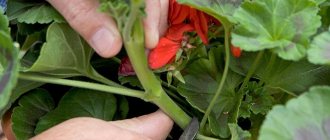Geranium is one of the most tenacious and unpretentious houseplants. Royal pelargonium is easy to care for and grow. It lives in outdoor conditions without any problems, so it is often found on balconies, summer verandas of cafes and the outer sides of windows.
Pelargonium is also incredibly popular due to its incredibly bright and varied colors. The range of colors varies from white to scarlet and dark lilac.
The only disadvantage of the plant is the intense unpleasant odor that appears as soon as someone touches the leaves. This is a protective reaction of the flower to pests, but people also try not to touch it again, but admire it from a distance.
Botanical description of the plant
The plant is popularly called royal geranium, although it belongs to the genus Pelargonium of the Geraniaceae family, subclass Rosidae. It has a lot of alternative names: domestic pelargonium, large-flowered, English, noble. It was bred artificially and came from closed-leaf pelargonium (cap geranium).
It is a potted plant but can grow into large bushes in mild climates. This geranium differs from other representatives in the shape and structure of the flower, as well as the splendor and arrangement of the inflorescences (not above the bush, but flush with the leaves). It blooms when it gets warm - from about April to August. The table below provides a brief description of the main morphometric parameters.
| Parameter | Description |
| Root system | fibrous |
| Stem | Erect, dense, almost completely hidden under the leaves |
| Leaf Shape | Simple, lobed, with a wavy, sometimes jagged edge |
| Leaf color | Greens |
| Flower shape | Large (usually from 4 to 7 cm), most often double, collected in umbrella-shaped inflorescences. Irregular, zygomorphic with only one plane of symmetry. The flower has a long nectar-bearing spur fused with the peduncle |
| Flower color | Varied: white, pink, red, lilac, maroon, purple. Characterized by dark veins and spots |
| Taste of Flowers | Bitterish, with a fruity minty note and rose aroma |
| Fruit shape | A long, narrow box with sepals, similar to the beak of a bird (hence “pelargos”, in Greek - “stork”) |
| Fruit color | Green, brown when ripe. |
Color variety
If you look at pelargonium in numerous photos, you can see that it amazes with its color diversity. She has beautiful flowers - small and large, simple and double, single-color and two-color, with and without dark veins...
Zonal pelargonium Pelargonium ivy-shaped Zonal star-shaped
Depending on the type of geranium, the color of the petals changes. They can be white, purple, pink, red, violet. Raspberry, lilac, and green shades are also quite real. Among all the varieties of geranium, it is difficult to find only one that has yellow flowers.
Main varieties
Over centuries of cultivation, more than a thousand varieties have been bred, and their classification is quite confusing. Thus, flower growers do not agree on whether to classify the famous “angels” species, which appeared as a result of crossing royal and curly pelargoniums, as large-flowered, or whether to consider them a separate species. In addition, pelargoniums andy flowers, often classified as Pelargonium domesticum, were actually developed by crossing "angels" and royals.
Did you know? Geranium flowers are used in cooking. They are candied and added to compotes and desserts.
One way or another, most often there are several groups of these plants (the royal ones, “angels”, candy flowers), which differ from each other in the shape, size and color of the petals, as well as resistance to environmental influences. Each group includes many varieties. Let's look at the most popular of them.
Royal pelargoniums:
| Variety | Flower color, characteristic features |
| White Glory | White without veins or spots |
| Rimfire | Black and burgundy with dark veins |
| Margaret Soley | Large (6 cm) light red |
| Joy | Red-pink, reminiscent of primrose |
| Black Prince | Dark plum with silver edge |
Representatives of the “angels” group (fragile-looking mini-varieties with fragrant foliage and a short flowering period):
| Variety | Flower color, characteristic features |
| Spanish Angel | Purple, 3–3.5 cm in diameter |
| Imperial Butterfly | Quite large white with wine-red splashes, leaves with a citrus aroma |
| Tip Top Duet | The upper petals are dark crimson, the lower petals are pale lilac. Characterized by early and fairly long flowering |
| PAC Angeleyes Viola | White with splashes of pink, leaves with a citrus aroma. |
Representatives of the candy flowers group (hardy varieties that do well in open ground) include:
- light pink with dark spots Cambi (Bicolor);
- dark cherry Camred;
- Camdared with their petals colored bright red on the inside and a paler shade on the outside.
Did you know? One of the Angeleyes varieties is PAC Angeleyes Orange Paccrio, which has orange flowers and a carrot-like scent to the leaves.
Varieties of indoor geraniums
Many people do not understand the difference between geranium and pelargonium, but these plants have differences. Geranium and pelargonium belong to the same family. The flowers that everyone is used to seeing on window sills and balconies are pelargonium grandiflora. Royal pelargonium is found in the homes of real professionals, because getting a good bush is not so easy.
How to feed geranium - means for abundant flowering and growth
Geranium also grows well in gardens, and it is quite unpretentious, unlike its sister. The indoor flower pelargonium has many varieties. They all have different flower shapes, bush lengths and shapes. Caring for royal pelargonium and geranium is approximately the same, but the appearance is very different.
Attention! Many inexperienced flower lovers confuse the plants and call geranium pelargonium and vice versa. From the point of view of the average person, the flowers are identical, as are the conditions for caring for them.
Geranium in peach tones
Descriptions of some popular varieties are given below.
Mandarin
This type of royal geranium has superb orange-pink flowers with splashes of red in the middle. The bush is medium in size, quite wide, but at the same time compact.
Mona Lisa
This geranium is called the most spectacular. The bush is powerful, ivy-leaved and reaches 60 cm in height. Large flowers have curly petals along the edges. The color of the inflorescences is bright and not monochromatic.
Flowering duration is at least 3 months.
Morwena
Geranium regal Morvena has very attractive dark flowers. The color is burgundy-black, the inflorescences are large and double.
The leaves of the bush have irregularities and are slightly jagged.
Elegance Jeanette
The flowers of this species are pink-white and small in size. The leaves are round, with uneven edges.
The inflorescences are not uniformly colored. Half of the flower can be deep pink or even red, but the other is completely white.
Clerion bright ed
The name of this royal geranium speaks of the shade of the inflorescences. Bright red flowers adorn this bush in large quantities.
The shrub is medium in size and easy to grow into a compact plant.
Conditions for successful growing at home
Royal pelargonium is quite finicky and requires special care and knowledge of the intricacies of cultivation. Otherwise, it simply will not bloom.
Lighting
Royal pelargonium loves light - without sufficient lighting it stretches in length, becomes unaesthetic and loses its immunity. Windows facing north or obscured by trees are not suitable for her. It is optimal to place the plant on the windowsills of south-facing windows, turning it several times a week at a slight angle relative to the window.
Important! Direct sunlight is dangerous for this type of geranium. In the summer, during hours when the sun is especially active, you can cover the windows with tracing paper or floral film.
Temperature
The temperature maximum in summer is 24 °C, in autumn the temperature begins to gradually decrease, and in winter, when buds are laid, it reaches 12–15 °C. To maintain this temperature regime, you can place the plant on an insulated terrace or balcony.
Air humidity
Avoid excessive dampness as this can cause fungal diseases. In addition, good ventilation is necessary to avoid stagnant air. At the same time, drafts are undesirable.
Royal geranium - what kind of flower
The royal geranium variety is considered the most attractive of this genus. The flower's homeland is South America, so it simply loves the humid climate and hot temperatures. With proper care, the plant blooms from mid-spring until autumn, as long as the weather remains warm.
red geranium
The flowers of the plant are large, painted in a wide variety of colors from white to deep purple. The diameter of the bush can reach 15 cm, the height of the flower is the same. Geranium buds are large with a terry covering. The edges of the petals may appear ruffled or slightly wavy.
Note! Each petal must have a dark stripe or spot. This dark marking is a distinctive feature of this species.
Home care
Having provided the necessary conditions of detention, you can begin care measures.
Learn how to care for geraniums in winter.
Watering
The watering schedule depends on the time of year. In summer, it is necessary to water abundantly 2 times a day with settled water at room temperature, but do not overdo it: stagnation of water is unacceptable. Royal pelargonium does not require spraying the leaves with water. For watering, experienced gardeners recommend using a tray, then the geranium itself absorbs the required amount of water with its roots. In winter, watering is reduced.
Top dressing
Feed during watering once every 2 weeks with special liquid complexes for ornamental plants (nitrogen-potassium-magnesium), at the beginning of the growing season introducing additional potassium for better bud formation. The popular method of feeding is to dilute a drop of iodine in a liter of water and carefully pour this solution over the walls of the pot. You should not overdo it with fertilizing - this will lead to burns and yellowing of the foliage.
How and when to prune
Flower growers who have not previously dealt with royal geraniums traditionally (and mistakenly) prune them in the spring, but this can lead to improper formation of shoots. The best time for pruning in this case is the beginning of September. For lush flowering and less trauma to the noble plant, pruning should be carried out in 2 stages.
The interval between procedures is about a month. First, dry and excess stems (about a third) are removed, and in the second stage, the formed young shoots are pinched, stimulating the active growth of new ones. When pruning, you must remember to use a disinfected tool and treat the cuts with activated carbon.
Read more about pruning geraniums for the winter.
Transfer
To maintain the decorative properties of geraniums, it is recommended to replant them every 2–3 years. It occurs when the plant's roots begin to poke through the drainage hole. The optimal time is from late January to March, when geranium wakes up after wintering, but is not yet preparing to bloom. A pot that is not too spacious is used, otherwise all the growth will go into greenery and there will be no flowers.
Recommended reading
How and when should you replant indoor plants?
The transplant process occurs as follows:
- Geranium is watered generously to make it easier to remove from the pot.
- The plant is removed along with a lump of earth and placed in a new pot.
- The voids between the container and the plant are filled with moistened soil (peat and sand or peat and perlite mixed in equal proportions).
- At the bottom of the pot you definitely need drainage holes and a layer of expanded clay or small pebbles.
Breeding and planting
It is very easy to propagate geraniums vegetatively. In spring or summer, it is necessary to cut off the tops of stems with several nodes. Sprinkle the damaged area with activated carbon powder and place it on paper in the shade to dry for a couple of hours. During this time, prepare the substrate for planting. Mix peat and sand in a container. Plant the cuttings in moist soil. Cover with polyethylene to create a greenhouse effect. This will better regulate substrate humidity and heat.
In water, shoots very rarely take root and more often rot. Periodically, using a spray bottle, you should moisten the soil of the “babies”. After about 3-4 weeks, the cutting will take root. Then it can be planted in a permanent place, in a larger container. The soil should consist of leaf and turf soil, sand. The “babies” can bloom as early as July.
It is important to know that pelargonium does not like free space, so the pot is selected so that the roots are a little cramped. Transplantation is carried out after flowering no more than once every 2-3 years.
After the procedure, flowering may decrease. During the transplantation process, all weak and elongated shoots are removed
You need to move it very carefully so as not to injure the root system. Good drainage must be ensured
It is better to purchase ready-made fertile soil at a flower shop.
Features of care in winter
Geranium spends the autumn-winter period in hibernation, which determines the specifics of caring for it in the cold:
- For sufficient lighting, fluorescent phytolamps are used.
- The air temperature drops to the already mentioned 12–15 °C.
- Mineral feeding is stopped.
- If geranium was planted in the garden for the summer (this is most often practiced with varieties of candy flowers), it is not left there for the winter, especially in the middle zone.
- Watering is reduced, focusing on the condition of the earthen clod - it should not be dry.
Pruning pelargonium
The reason why royal pelargonium does not bloom may be incorrect or insufficient pruning. Since the plant grows quickly and buds form at the tops of the shoots, it is easy to increase pure flower buds by pinching or cutting off the tops of overgrown stems in July and August. This measure will allow:
- use the resulting cuttings for propagation;
- achieve lush flowering next season;
- stimulate the growth of young shoots;
- give the bush a compact, attractive shape.
It is better to prune the plant gradually, without seriously injuring the pelargonium, and after the operation the plant must be fed. At the end of winter, with the beginning of new bud formation, pruning is completed.
Reproduction
All flower growers are interested in the issue of propagating royal pelargonium, because such beautiful flowers necessarily require reproduction. There are two methods of reproduction, which have their advantages and disadvantages.
You will be interested to know about propagating royal geranium at home.
Cuttings
It is produced by rooting cuttings, which are taken no earlier than the end of January - then the level of growth hormone increases, but no later than March - bud formation begins in the spring. It is recommended to immediately use separate pots with drainage holes. After cutting, the edges of the cuttings are treated with activated carbon powder, dried and planted in the ground (the same mixture is used as for replanting).
Young plants are kept in a moderately warm room (19–22 °C), not forgetting about watering, and fed with mineral complexes with a reduced nitrogen content twice a month (so that fewer leaves grow and more flowers). Pinching (removal of apical buds) is done for the first time after a few weeks over the third pair of leaves and stops when the pelargonium acquires the shape and bushiness desired by the owner.
Growing from seeds
Propagation by seeds is not a very successful method for this particular type of geranium, primarily because it is difficult to find high-quality seeds in domestic stores. In addition, with this type of propagation, such a trait as the doubleness of flowers is almost not transmitted.
If the grower still decides to sow Pelargonium domesticum, it is better to do it in winter. The air temperature in the room should be at least 20 °C, the soil in the box with seedlings should be kept moist. Shoots usually appear in the 3rd week. After this, the seedlings are transferred to a temperature regime of 15 ° C and, when the first leaves appear, they are planted in pots, not forgetting about tweezing.
How to control pests
Despite the repellent system with smell and fibers on the leaves, there are separate groups of parasites that infect the plant. Especially under unfavorable care conditions or chronically dry air in the room.
- Whiteflies . The main pest that most often affects royal pelargonium. This is an insect similar to a white moth, but up to 2 mm in size. Its appearance is indicated by yellow spots on the leaves.
- Aphid . Small green winged insects that fly from an open window or move from a new flower that was infected in a previous habitat. They settle mainly on leaves.
- Spider mites are a rare guest on pelargonium. Occurs on smooth-leaved species that do not emit a repulsive odor. Lives on the lower part of green plates. When affected, a thin web appears and the flower develops slower.
- Termites . Pelargonium, a plant with a gradually woody base of the trunk, is subject to invasion by ants. These unwanted guests differ in size and appearance from ordinary forest borers - they are smaller and have a dark green, swamp color. Dangerous for old plants that have not undergone the rejuvenation procedure.
- Caterpillars . First, light spots, and then full-fledged holes on the leaves indicate that green caterpillars have appeared in the pelargonium bush. They develop in buds, which is where you should look for them first. If there is a heavy infestation, you will have to completely get rid of the flower stalks.
The procedure for controlling insects is the same in all cases:
- Isolate the damaged plant from the rest in quarantine.
- Get rid of the affected areas.
- Causing minimal damage, mechanically clean the leaves and stems of visible insects using a sponge soaked in a soapy solution. Cover with a bag and leave for 30 minutes. In this case, the soil is separately wrapped in polyethylene so that the soap does not get into the soil.
- If it doesn’t help, which can be seen after a week, for further control you will need one of the following insecticides: Marathon, Messenger, Montreuil. Treatment is carried out according to the instructions on the drug packaging.
- Among the traditional methods, a product prepared according to this recipe destroys pests: dissolve 1 aspirin tablet in 8 liters of water and spray on the plant. For treatment - on the 1st, 3rd, 7th days. For prevention - every month.
- If geranium is severely damaged, it will be necessary to wash the soil with actara 3 times weekly.
In order not to start the disease and not cause the plant to die, it is recommended to carry out a preventive check of geraniums for the presence of pests every 7 days. They mostly hide under the leaves and appear in the summer.
Difficulties in growing
As we have already seen, caring for noble pelargonium has many nuances, failure to comply with which leads to diseases and pest damage. Let's look at possible problems and how to deal with them.
Find out what to do if geraniums don't bloom.
Doesn't bloom
The most common question that worries gardeners is: why does pelargonium not bloom even with seemingly proper care and what to do about it. You can answer it like this:
- One reason may be the composition of the soil. If the soil is exclusively peaty, then it does not allow air to pass through well and retains moisture too much. Therefore, the soil must contain sand.
- Very often, owners of pelargoniums literally flood them with water, which cannot be done, as this causes the leaves to turn yellow and flowering stops.
- Too large, spacious pots allow the development of the root system to the detriment of flowering.
- Pest infestation also negatively affects decorative functions.
Diseases
The most common disease to which these plants are susceptible is blackleg. The reasons for it lie in infection with the Pythium fungus due to improper care: too cold a room, large pots, excessive watering. A characteristic sign is blackening of the stems.
It is practically useless to treat the plant; it is better to take care of its re-rooting. Yellowed foliage can be a sign not only of too much watering, but also, paradoxically, of insufficient watering, small pot sizes, small or, conversely, excessive amounts of fertilizing.
Important! Freshly planted cuttings are most susceptible to blackleg, so under no circumstances should they be covered with polyethylene, thus creating a wet bath effect that is beneficial for the fungus.
Pests
The main winged enemy of pelargoniums is the whitefly, which looks like a tiny white butterfly. Yellow spots on the leaves usually indicate a whitefly infestation. At the initial stage, you can try to wash off the midges from the plant with a damp cotton swab, but the classic method of control is to water the soil three times (at weekly intervals) with Aktara.
Caring for noble pelargonium differs in many ways from caring for other members of the genus. To understand how to make royal geraniums bloom, you need to remember and follow the nuances associated with watering, pruning and disease prevention discussed in the article.
Landing rules
Let's get acquainted with the basic rules regarding planting dwarf pelargonium.
Lighting and location selection
Important! In order for dwarf pelargonium to bloom beautifully and for a long time, it needs to grow in a well-lit place. With enough sunlight, the plant's petals are brighter and greener.
If pelargonium experiences a lack of light, its decorative effect will fade: there will be fewer inflorescences and the leaves will turn pale.
However, the plant does not tolerate direct rays: at midday, therefore, it is recommended to shade pelargonium. In winter, so that the flower does not lose its decorative effect, it needs to be provided with additional artificial lighting.
In order for the crown of the plant to form compactly, it is recommended to periodically turn the pot towards the window with different sides. This way, the sun's rays will be able to reach all parts of the plant, and the pelargonium will stretch evenly.
Temperature
In summer, pelargonium should be kept in moderate temperatures: +17+23 degrees will be ideal. The plant should not be allowed to overheat. It is better for a flower to overwinter at a temperature of +12-13 degrees, not higher, since at this time the plant should slow down all its vegetative processes and rest.
The soil
Note that dwarf pelargonium is not too demanding on the composition of the soil. The main thing in this case is to provide the plant with good drainage so that the moisture in the pot does not stagnate.
Soils with a neutral or slightly alkaline reaction are best suited for the plant. If the soil is acidic, it is recommended to neutralize it with ash. The recommended substrate composition is as follows:
- part of the humus;
- part of the leaf soil;
- part of the turf;
- part of the river sand.
